These pictures are from my 4 month trip with the M/S "Lexa Maersk". The ship sailed between Europe and
South America, bringing mainly fresh food and frozen meet to Europe and various technology to South
America. The Lexa Maersk, along with her large number of sister vessels, have the largest reefer
container capacity in the world, as they have power outlets for 1110 containers! The principal data
are as follows:
The following pictures are all taken by me, Ebbe Holsting, and are copyrighted. However, should
you wish to use them in any way please
contact me for permission.
Thank you! By clicking any picture a larger version will open in a new window.
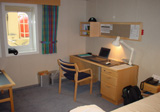
|
My cabin onboard, typical for junior officers, able seamen, ratings and cadets. The cabin includes a
bathroom with toilet and shower. Senior Officers (Captain, Chief Engineer, Chief Officer, 1st Engineer)
typically have larger cabins with separate bedroom and living room, and often the Captain and Chief Engineer
also have a separate office. |
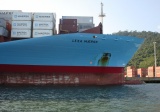
|
Berthed at Sepetiba, Brazil, one of the life boats was launched for the monthly drill. Lexa's
route includes the South American ports of Sepetiba, Santos and Pecem (all Brazil), Buenos Aires
(Argentina), Montevideo (Uruguay) and the European ports of Algeciras and Vigo (Spain), Thamesport
(England), Rotterdam (Netherlands), Bremerhaven (Germany) and Le Havre (France). |
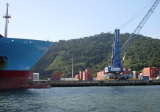
|
The mobile crane to the right is used in many South American ports, being an alternative to
the more common Gantry Crane (seen in the pictures from Santos further down). The port of Sepetiba
is located about 60 miles from Rio de Janeiro and was established due to regular congestion in Rio. |
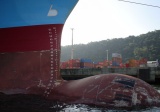
|
A view at the ship's "Bulbous Bow" designed to enhance the ship's aqua dynamics. This
type of bow was developed through scientific studies of whales! The numbers written on the side of
ship indicate the ship's draft. The larger numbers are in feet, and the smaller ones followed by an
"M" indicate whole meters. |
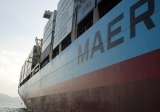
|
A glance down the side of the ship. The brown paint on the bottom half of the side is inteded
to wear off quicker than regular paint, in order to prevent algee and sea weed from growing on the
underwater part of the hull. Extremely effective! |
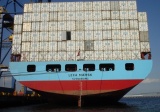
|
The aft most bay fully laden with empty reefer containeres for discharge in Santos and Buenos Aires.
Notice the open container door. We didn't attempt to close the door on board since the container was
empty. Had it been a reefer carrying a load the situation would have been much different, and most
likely we would refuse to transport the container. |
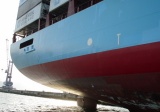
|
A good look at the ships stern. The large white "T" on the side of the ship indicates
that tug boats may push the ship at that particular point, since the hull is fitted with extra
reinforcements in that place. The circle with a cross next to the T indicates that the ship is
equipped with a stern thruster (athwartships propeller). |
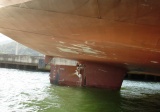
|
Moving further aft we have a look at top of the ship's rudder. The propeller has a diameter of
8.3 meters (27.2 feet) and weighs 70 tons! If sailing full ahead in a loaded condition (24 knots)
and reversing the engine to full astern it would take 12 minutes for the ship to come to a full stop,
and the ship would have moved 4.3 nautical miles (8 kilometers) between the point of reverse and the
point of full stop. |
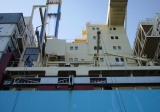
|
The two arms with the wires hanging from them are the lifeboat davits. When launching the lifeboats
these davits swing out over the side and the boat can then be lowered to the water. In case of an
actual abandon ship emergency then boat can be launched from the inside, so no people are left on
board. In addition to the two lifeboats the ship is also equipped with five life rafts. |

|
Not much cargo abaft of the accomodation in this particular picture. However, notice the two
large grey structures to the right of the middle. They are wings for a wind mill and they were
transported by lashing them to a so called "Flat Rack" container. A Flat Rack container is
more or less just the bottom of a regular container, meening it has no ceiling or walls. |

|
On the aft most container bay I captured this funny coincidence. As seen on the picture the
containers on this bay form a ceiling over the aft mooring deck (poop deck), which is always a
welcome thing if it is raining during mooring operations. A typical mooring operation takes about
half an hour from the first line being thrown in and until all lines are tight. |
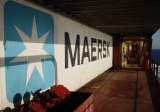
|
The upper deck starboard passage way, here standing at bay 48 just aft of the accomodation. As
seen in the picture this bay has no hatches, this of course due to the location of the engine room
just below the deck here aft of the accomodation. Notice that we are standing under a container in
this picture. Not a single square foot of deck space is wasted on board these ships! |
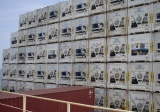
|
Since most of the cargo from South America to Europe consists of reefer containers, a lot of
empty reefers are transported the other way. Some reefer containers can maintain an internal temperature
as low as -70° Fahrenheit (-57 Celsius)! Other reefers can control the humidity of the atmosphere
inside the container, and a very rare type can even extract carbon dioxide from atmospheric air and
ventilate the cargo with this gas. This is very effective when transporting fruit, but the system is
not that common. |
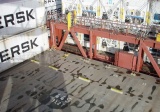
|
A typical container bay has three hatches. A starboard, a center and a port hatch. This is the
hatch of bay 44 starboard and as seen on the hatch it weighs 31.2 tons. These hatches are locked to
the ship in each of their corners by a simple locking mechanism. Container cranes ashore lift off
these hatches when loading or discharging in the cargo holds. |
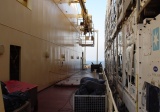
|
The crane deck on the aft part of the accomodation. This deck is located three decks above the
upper deck (cargo deck), and from here stores and provision can be lifted on board with the monorail
crane. The hatch in the middle covers a long vertical shaft leading all the way down to the engine room
(5 decks under the crane deck), so the stores for the engine department can easily be lowered into
the department where they are needed.
|
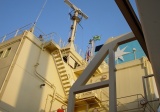
|
A look up the aft end of the accomodation, here from port side of the ship's crane deck. One of
the radar scanners is seen in the top of the picture. The ship is equipped with to seperate radar
systems. The Brazilian flag is also visible. When navigating in national territorial waters the
flag of the corresponding country is always flown. The flag of the country in which the ship is
registered is flown aft. |

|
A view of the bunker manifold from my cabin. Lexa Maersk consumes about 200 tons of heavy fuel oil
per day and has a relatively limited fuel oil capacity, so bunkering (refueling) is done every two
weeks or so. Bunkering is usually carried out while the ship is at berth. A small tanker called
a bunker barge then goes alongside on the ship's free side and a hose is connected from the barge
to the bunker manifold. Bunkering usually takes about 6 to 8 hours on this container ship class. |
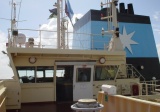
|
A view of the wheel house from the bridge wing in port side. The roof of the wheel house is called
the "Monkey Island". Antennas for the ship's various radio equipment is placed here as well as a mast
carrying the navigational lights. On top of the funnel, to the left, the foremost part of the whistle is
just visible. The whistle is used when navigating in fog and as a means of signalling the ship's intentions
during collision avoidance manouvers. |
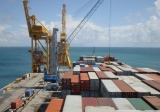
|
At berth in Pecem, Brazil. The harbour is very small and only has two berths. The pier is located about
two kilometers from shore in order to obtain an adequate water depth. The container terminal is located ashore
so the containers are transported out to the pier by trucks on a long bridge. The pier itself is actually
located in the Atlantic Ocean, only protected by two breakwaters. |
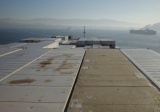
|
Approaching Santos, Brazil with visibility restricted by a light haze. The approach to Santos is actually
very exciting since you have to sail through a narrow channel just beside the city skyline in order to reach
the port. Tall buildings a few hundred feet away is quite a sight from the bridge of the ship! |
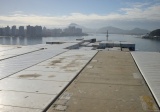
|
Another view of the approach to Santos, here with the narrow channel visible in front of us. A large marina
with very exclusive boats, not visible in this picture however, is located on the right side of the channel. |
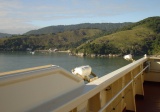
|
The approach to Santos is certainly surrounded by magnificent nature! During entry to any port a local
pilot embarks the ship. The pilot is familiar with the local water depths and currents and is therefore
needed in order to navigate the ship safely. However the pilot does not assume command of the
vessel, opposite of what most people think. The Captain is always in full command. |
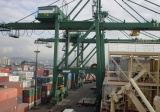
|
Berthed at Santos, the gantry cranes commence the cargo operation. A stay in Santos with the Lexa Maersk
usually takes about 12 hours. During my time on board Santos was a popular port for carrying out major overhauls
on the Main Engine, i.e. changing two pistons. However we still had some time for shore leave. |
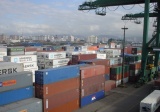
|
Still Santos with a view of the terminal. Santos downtown in the background. |

|
A look the other way from the same situation as above. A large bulk cargo terminal was located on the
other side of the harbour basin. |
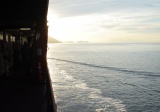
|
Once again a view of the fabulous South American nature, here just after departure from Santos en route
to Buenos Aires in Argentina. Though barely visible in this picture, loads of small boats circled the vessel
and waved at us. |

|
Quite self explanatory. |
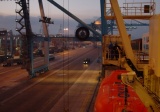
|
At berth in Algeciras, Spain, our first port of call in Europe when coming from South America. The two
crewmembers in the middle of the picture are working with the ship's crane, loading our life rafts. They had
been unloaded earlier the same day for a routine inspection carried out every five years. |
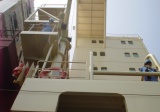
|
Once again time for testing the MOB (Man Over Board) boat. This picture taken sitting in the boat while
being lowered off to the water. Chief Officer Thomas to the left operating the boat crane. |
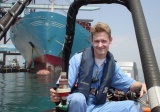
|
Here I am carrying out one of my favorite routine checks: testing the MOB boat. That is always a great
opportunity for shooting some pictures of the vessel from the sea side. Of some strange reason my MOB boat
testings have almost always taken place in Algeciras. This was the case on Clifford, Lexa and even Svend
Maersk. Pictures from all three occations can be found on this home page. |
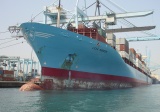
|
A great view of the entire vessel berthed at Algeciras. One voyage with Lexa from Europe to South
America and back took 6 weeks. I was on board for three voyages, so in total I visited Algeciras 7 times,
including the one where I embarked the ship. |
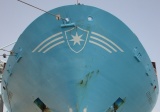
|
An awe inspiring view of the mighty bow. Lowering the anchors during port stay is not normal practice,
and this was only done because the ship's maintenance crew consisting of four Thais were painting in the
anchor fairleads. A rope ladder can be seen on the anchor to the left, this allowed the painters to crawl
down through the fairlead from the forecastle. |
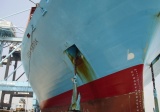
|
Standing on a rope ladder inside the anchor fairlead might sound dangerous, but the painters were
waring safety harnesses. No work on board is carried out without due concern to the safety of the crew.
The fairleads on Lexa Maersk are approximately 2 feet in diameter, so there was actually quite enough room
for the painters to work in them. |
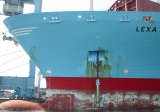
|
A view of the port bow. The symbol just to the right of the anchor chain indicates the position (and
presence) of the bow thruster. The symbol on the other side of the chain indicates that the ship is fitted
with a boulbous bow, designed to improve the vessel's aqua dynamics. |
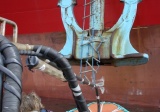
|
Up close to the starboard anchor. Each anchor weighs about 14 tons! When anchoring, the anchor itself is
actually not holding the ship in place, it is the weight of the anchor chain that does this. The anchor
winches on Lexa Maersk are, like the mooring winches, driven by one electric motor each. |
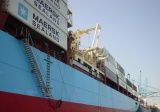
|
With the MOB boat back on board, we are now testing the port side lifeboat. To the right of the middle
in the picture we see the lifeboat hoist wires. To the left we see a so called "Pilot Combination", the
combination of rope ladder and aluminum gangway which the pilot uses when embarking and disembarking the
vessel. The bottom of the rope ladder is seen lifted upwards. This is done to prevent unwanted people from
embarking the ship while at berth. When the combination is to be used, the bottom of the ladder is lowered
off to approximately 3 feet above the water. |
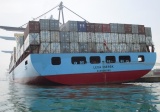
|
Viewing the transom of Lexa Maersk reveals a slight list to port during the cargo operation. The ship
is fitted with a socalled "Ballast Heeling System" consisting of a starboard and a port side ballast water
tank and a pump between these tanks. By pumping water from one side to the other, the ship can be held at
an even keel during cargo operations. Too much list will impede loading and discharge of containers. |
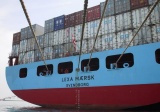
|
Returning some ten minutes later the heeling system has cancelled out the list. Lexa's stern was usually
moored with four stern lines (ropes), as seen here, and a stern spring line. The spring line goes out from
the side of the stern mooring deck and is moored to a bollard placed futher abow. The bow of the vessel was
moored with four head lines and one or two spring lines, these spring lines naturally moored further astern. |
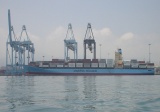
|
Lexa Maersk in profile, picture taken from the other side of the harbour basin. All A. P. Moller - Maersk's
container vessels carry the "Maersk Sealand" name on the side. It was formerly known as Maersk Line, but this
was changed when A. P. Moller - Maersk bought the american shipping company Sea-Land in 2001.
|
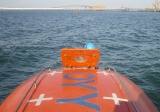
|
The view when standing up at the manouver position of the life boat with my head through a hatch in the
roof. Lexa's call sign is printed on the roof of the life boat so that it can be seen from rescue aircrafts
in the event of an emergency. The white crosses have no particular meening but they are made from reflective
tape in order to ease sighting of the boat during dark hours. |
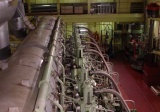
|
Lexa's main engine, a 10 cylinder two stroke crosshead diesel engine from danish contructor Burmeister
& Wain. The large grey tank to the left is the exhaust receiver, into which the exhaust gasses are led
before entering the turbo chargers. The purpose of the receiver is to give the exhaust gasses a constant
pressure upon entering the turbo chargers. On some older engine designs the exhaust gasses were led directly
to the turbo chargers, technically called Pulse Turbo Charging. |
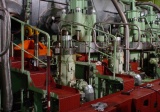
|
One of the many main engine piston pulls I participated in on board. A piston pull meens replacing a piston
on the main engine is replaced. With the cylinder cover lifted out of the way, fellow cadet Hasse is watching as
the piston is being lifted out of the cylinder by the engine room crane. The orange thing to the left is the
lifting tool which is mounted directly on the top of the piston. |

|
With the old piston and piston rod out of place, the new set is being guided to a position above the cylinder
for lowering into the engine. The piston itself weighs a few tons, and the piston rod weighs 8 tons! Imagine this
weight moving up and down more than 90 times a minute! Incredible forces at play in these huge engines. |
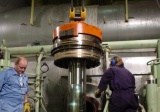
|
A few moments later the piston and rod is slowly being lowered. Chief Engineer to the left and First Engineer to
the right, operating the crane. First Engineer is wearing a set of blue ear protecters with built-in radio on her
head. This allows her to communicate with the Second Engineer who sits inside the engine and helps guide the piston
rod on its way down through the cylinder. Don't worry, he won't have to crawl up through the cylinder. He can escape
through a hatch further down. |
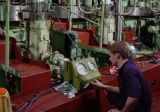
|
Later in the operation the new piston and piston rod is in place. Now the cylinder cover is being mounted. Here
I am operating a hydraulic pump pressurising a set of hydraulic jacks in order to fasten the cover to the cylinder.
By applying 900 bars (!) of oil pressure to the jacks, the bolts holding the cover are streched a few millimeters, allowing
the nuts to be tightened by hand. When the pressure is released from the hydraulic jacks, the bolts and nuts holding
the cylinder cover are tight enough to resist the massive forces inside the cylinder as well as the rough vibrations
shaking the entire engine when running. |

|
Me standing beside the piston taken out of the engine. The piston is covered in coke and other fuel oil residuals
which build up on the piston during operation. Once the piston has been cleaned of all these residues and the piston
rings have been changed, the piston is subject for a thourough inspection where several messurements are taken and
compared to similar messurements on a new piston. If the wear of the piston is found to be within a certain acceptable
margin the piston can be used again. |
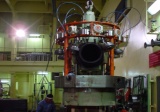
|
The cylinder cover itself, weighing in at about 8 tons. Note the orange tool fitted on the cover. That is the tool
carrying the hydraulic jacks used for loosening and tightening the nuts holding the cylinder cover in place. The motorman
visible in the picture, he was responsible for cleaning the inside of the cylinder cover i.e. the actual combustion
chamber. |














































